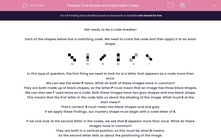Get ready to be a code breaker!
Each of the shapes below has a matching code. We need to crack the code and then apply it to an extra shape.
-06.png)
In this type of question, the first thing we need to look for is a letter that appears as a code more than once.
We can see the letter P twice. What do both of these images have in common?
They are both made up of black shapes, so the letter P must mean that an image has three black shapes.
We can also see T used twice as a code. Both these images have two grey shapes and one black shape.
This means that the first letter in the code tells us about the shading of the image. What must S at the start mean?
That’s correct! S must mean two black shapes and one grey.
If we apply these findings, our mystery shape must begin with a code letter of S.
If we now look at the second letter in the codes, we see that D appears more than once. What do these images have in common?
They are both in a vertical position, so this must be what D means.
So the second letter tells us about the positioning of the image.
U is used as code for a diagonal from top left to bottom right.
F is the code for a diagonal from bottom left to top right.
Therefore, the code for our final shape is SU.
S for two black shapes and one grey shape, and U for a diagonal from top left to bottom right.
Let’s try another one with a three-letter code this time:
Which code should the final shape have?
-07.png)
We can see the letter J appears twice, what do these two images have in common?
They both have an unshaded shape inside the main shape. This means that H is used for a shaded shape on the inside and J is used for an unshaded shape on the inside. If we apply this logic, then our mystery image must have an H in the middle of its code.
What do the two images with a G in their code have in common?
They both have circles inside, so G means a circle inside and S means a square inside. If we apply this logic, then our mystery image should have an S at the end of its code.
Finally, what could the first letter of the code stand for as they are all different?
The only other feature that changes between the images is the type of shape used as the outer shape.
The letter Z must be used for an oval, which is the same as our mystery image.
If we bring this all together, our mystery image should have the code ZHS.
Z - oval on the outside
H - shaded shape on the inside
S - square on the inside
Want a bit more help with this before you begin? Why not watch these short videos?
It’s now your turn to crack some codes!
Good luck detective.








